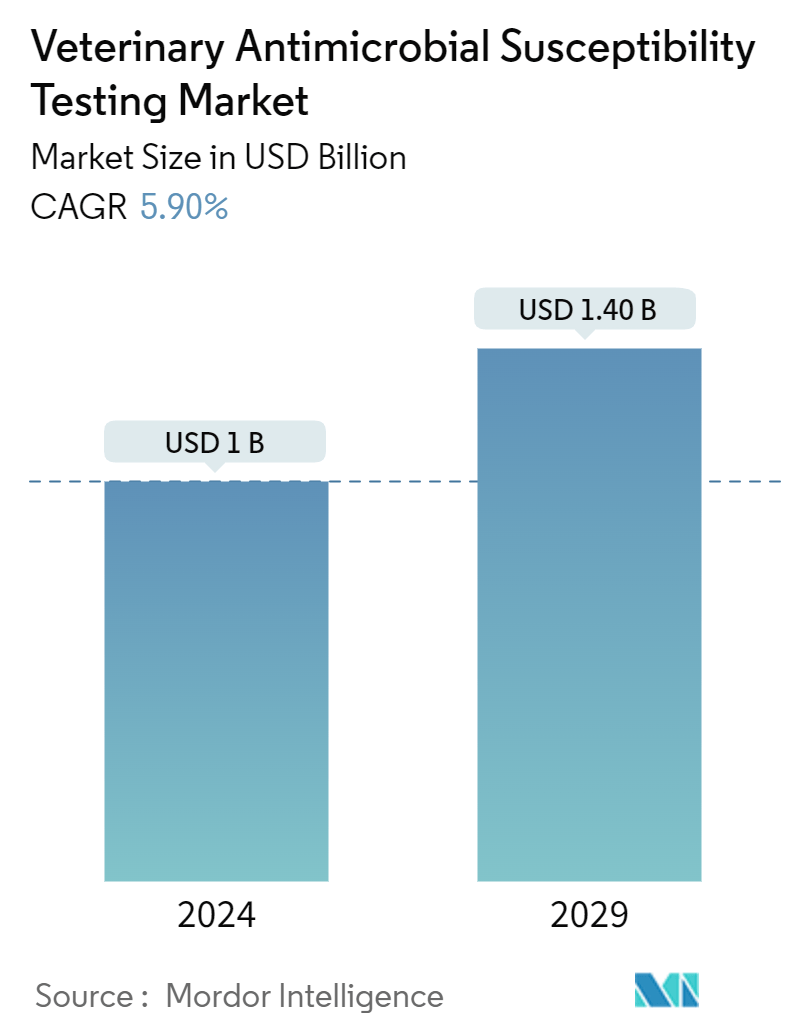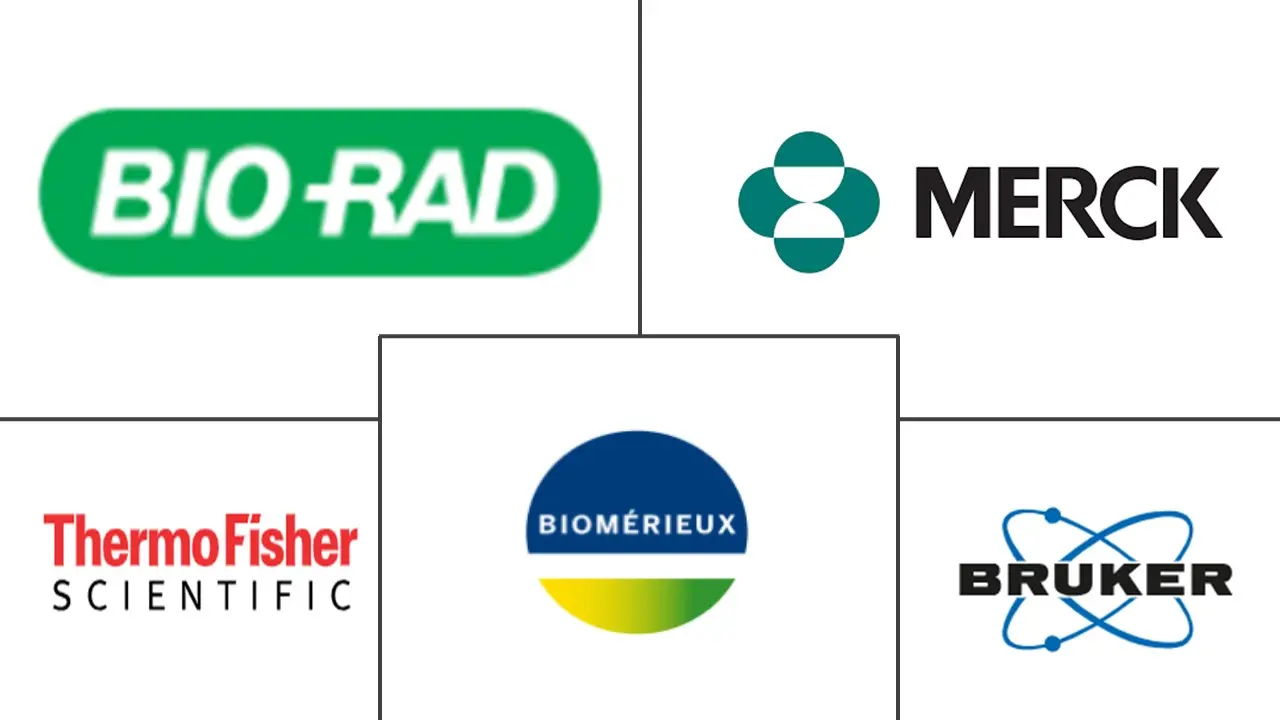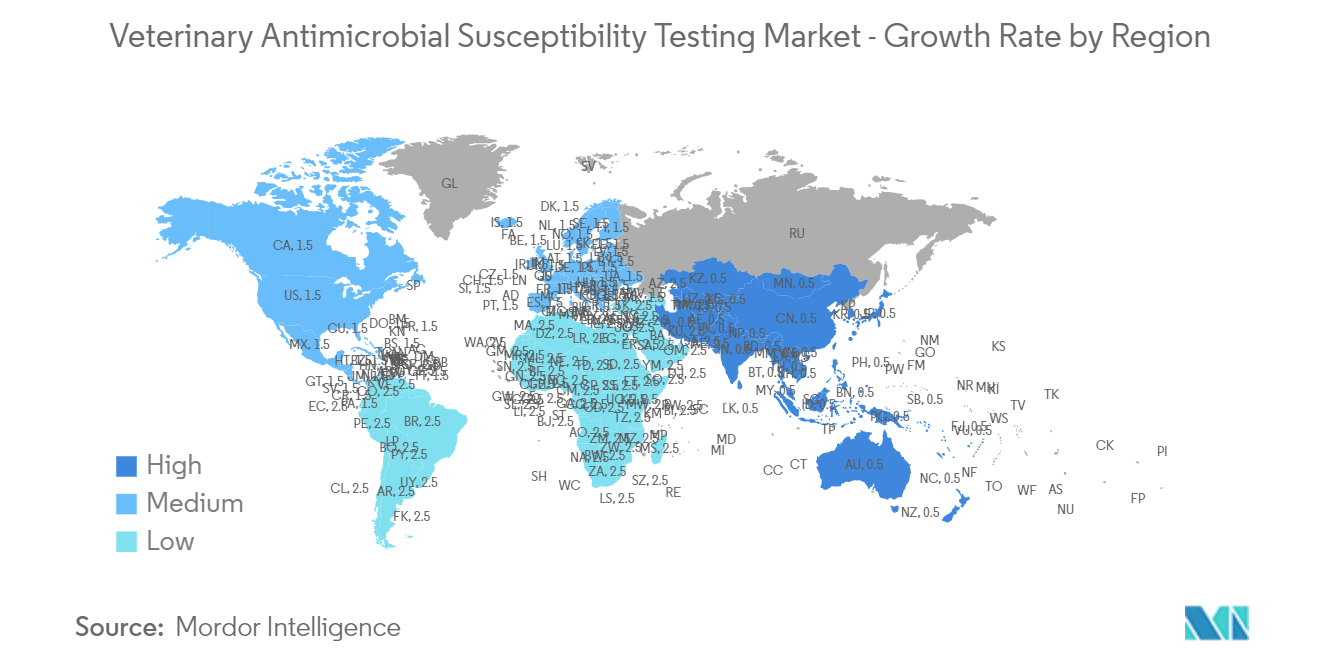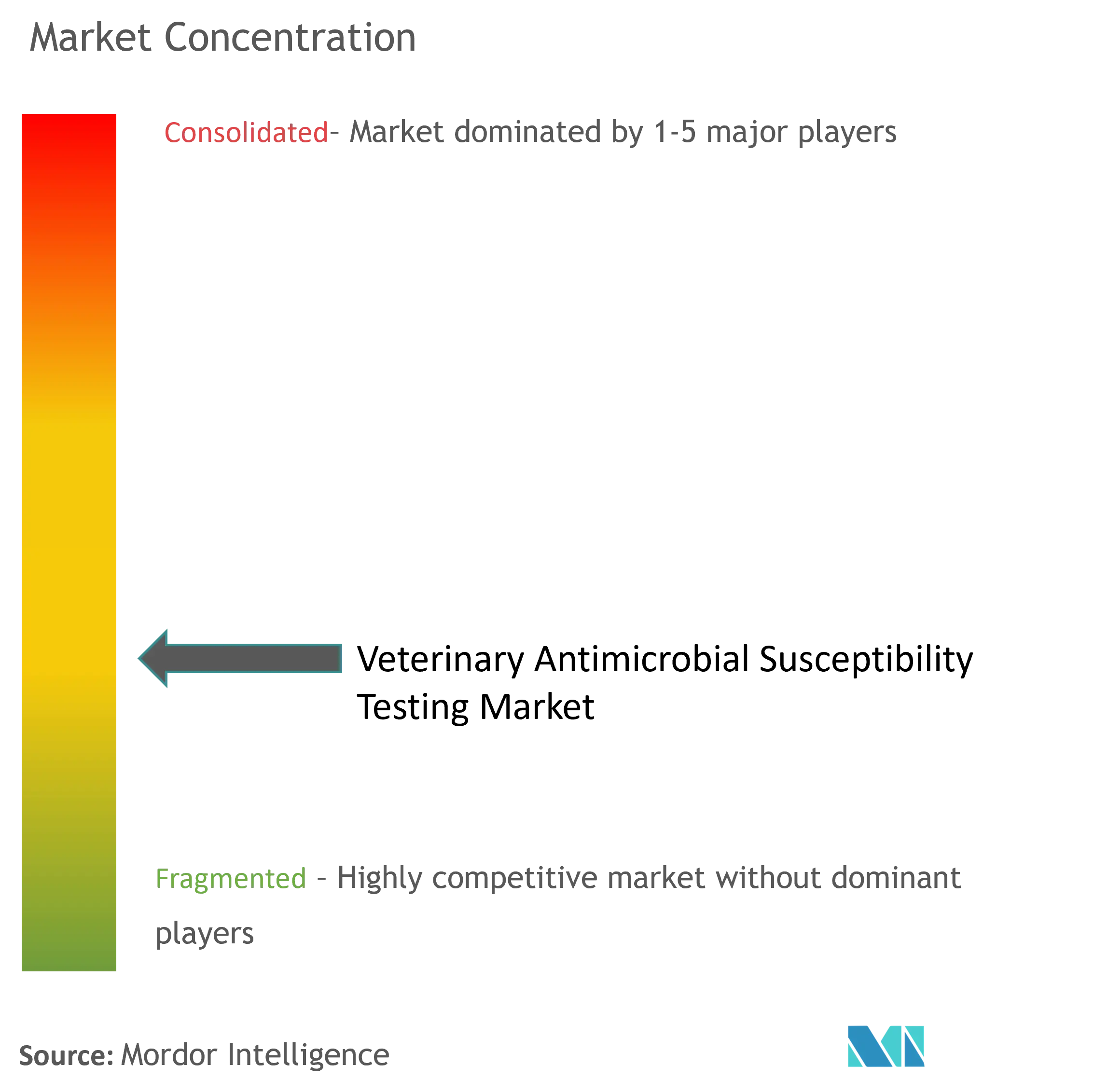Veterinary Antimicrobial Susceptibility Testing Market Size

| Study Period | 2019 - 2029 |
| Market Size (2024) | USD 1 Billion |
| Market Size (2029) | USD 1.40 Billion |
| CAGR (2024 - 2029) | 5.90 % |
| Fastest Growing Market | Asia Pacific |
| Largest Market | North America |
Major Players
*Disclaimer: Major Players sorted in no particular order |
Veterinary Antimicrobial Susceptibility Testing Market Analysis
The Veterinary Antimicrobial Susceptibility Testing Market size is estimated at USD 1 billion in 2024, and is expected to reach USD 1.40 billion by 2029, growing at a CAGR of 5.90% during the forecast period (2024-2029).
Rising antimicrobial resistance (AMR) had been ringing alarm bells across the world long before COVID-19. Globally, there was an alarming trend of multi-drug resistance as the pandemic grappled. As per the article published during Covid under the title “Antimicrobial susceptibility patterns of respiratory gram-negative bacterial isolates from COVID-19 patients in Switzerland,” the development of bacterial superinfections in ventilated COVID-19 patients was impacted by high levels of AMR, which in some situations necessitate continued modification of antibiotic therapy. The result of drug-resistant infections made illnesses more prolonged. Death rates became more severe and common. COVID-19 significantly impacted the market studied.
AMR poses a global problem that jeopardizes the effectiveness of treatments for bacterial infections and hampers essential medical advancements in veterinary medicine, such as complex surgeries and chemotherapy. According to the World Health Organization (WHO), if not effectively managed, AMR could lead to an estimated 10 million annual deaths by 2050, a number comparable to other severe illnesses such as cancer.
The rise of AMR has emphasized the pivotal role of clinical microbiology laboratories in promoting the responsible use of antibiotics and guiding appropriate treatment choices. Susceptibility testing is crucial in providing guidance for antimicrobial treatment, as antimicrobial resistance is one of the top public health challenges globally. Insufficient use or inadequate utilization of microbiological culture and antimicrobial susceptibility testing (AST), along with excessive reliance on empirical antibiotic treatment, can contribute to the worsening of AMR in veterinary healthcare. To address these challenges, a closer collaboration between diagnostic laboratories and healthcare providers is necessary to effectively implement antimicrobial stewardship practices, thereby accelerating the demand and leading the growth of the veterinary antimicrobial susceptibility testing market.
However, challenges such as high cost associated with testing and limited awareness and training gaps could impede innovation and rapid expansion of the veterinary antimicrobial susceptibility testing market. Despite acknowledging the importance of antimicrobial treatment, there remains a significant need to standardize the training of clinical microbiologists and the diagnostic procedures they use. This need is especially pronounced in the field of veterinary clinical microbiology, where additional challenges exist in fulfilling professional roles.
Improving the output of veterinary microbiology laboratories requires addressing specific issues, such as the harmonization of methodologies used for antimicrobial susceptibility testing (AST), the establishment of guidelines for interpreting and reporting AST results for animal pathogens, guidelines for detecting antimicrobial resistance mechanisms in animal isolates, standardization of diagnostic procedures for animal clinical specimens, and the increased training of veterinary clinical microbiology specialists.
Veterinary Antimicrobial Susceptibility Testing Market Trends
The Automated Testing Systems Segment is Expected to Dominate the Veterinary Antimicrobial Susceptibility Testing Market During the Forecast Period
Automated testing systems play a pivotal role in the veterinary antimicrobial susceptibility testing market, offering efficient and standardized methods to assess the susceptibility of microbial pathogens to antimicrobial agents. These systems streamline the testing process, providing accurate and timely results that are crucial for effective treatment decisions in veterinary medicine.
Automated testing systems enable high-throughput screening of multiple samples simultaneously, significantly reducing testing time compared to manual methods. This efficiency is crucial in veterinary settings with a high caseload. For instance, in June 2023, the PA-100 AST System, developed by Sysmex Europe SE based in Norderstedt, Germany, is a state-of-the-art automated urine analyzer that accelerates antimicrobial susceptibility testing (AST) directly at the point of care. It utilizes a unique combination of phase contrast microscopy and nanofluidics to produce antibiograms onsite. This advanced technology, based on nanofluidics, guarantees exceptional diagnostic accuracy. With its user-friendly interface and efficient operation, the PA-100 AST System can detect bacterial growth and conduct AST within an hour, yielding results that adhere to EUCAST standards.
Hence, ongoing technological advancements and product approvals for automated testing systems are further projected to propel the growth of the veterinary antimicrobial susceptibility testing market.

North America is Expected to Dominate the Veterinary Antimicrobial Susceptibility Testing Market
Antibiotics are prevalent in animal husbandry to promote growth and prevent infections in livestock and poultry. However, this practice leads to the emergence of antibiotic-resistant bacteria, which can be transmitted to humans through the food chain. Consequently, it poses a risk to food security, compromising both the availability and safety of food.
To effectively tackle antibiotic resistance, it is crucial to foster cooperation among various stakeholders, such as government bodies, businesses, educational institutions, and advocates for animal health. Furthermore, key product launches, the high concentration of market players, and the manufacturer's presence in the United States are some of the factors driving the growth of the country's veterinary antimicrobial susceptibility testing market.
For instance, in June 2023, Avails Medical, a manufacturer of rapid, automated, and fully electrical antibiotic susceptibility testing (AST) solutions, announced the submission of its eQUANTTM system for US FDA 510(k) clearance. The system can provide standardized inoculum directly from a positive blood culture, designed to be used with traditional automated AST systems and disk diffusion, accelerating routine AST turnaround times by up to one day. Therefore, owing to these benefits being incorporated into products, the market studied is anticipated to grow in North America.

Veterinary Antimicrobial Susceptibility Testing Industry Overview
The veterinary antimicrobial susceptibility testing market is fragmented, as multiple companies offer diagnostic kits and testing services in this domain. The market includes a mix of established players such as Merck KGaA, Bio-Rad Laboratories Inc., Thermo Fisher Scientific Inc., bioMérieux SA, and Bruker Corporation. The market also includes emerging companies and regional laboratories specializing in veterinary diagnostics.
Veterinary Antimicrobial Susceptibility Testing Market Leaders
-
Merck KGaA
-
Bio-Rad Laboratories, Inc.
-
Thermo Fisher Scientific Inc.
-
bioMérieux SA
-
Bruker Corporation
*Disclaimer: Major Players sorted in no particular order

Veterinary Antimicrobial Susceptibility Testing Market News
- November 2023: According to the Veterinary Medicines Directorate's report, the United Kingdom witnessed the lowest-ever recorded sales of veterinary antibiotics. The report emphasized the importance of minimizing the unnecessary use of antibiotics to combat the development of antibiotic resistance. It also presented encouraging data indicating a reduction in resistance across various significant indicators.
- November 2023: The Gambia developed a fully costed National Action Plan on Antimicrobial Resistance (2023‒2027), which identified key measures to be implemented by 2027.
Veterinary Antimicrobial Susceptibility Testing Market Report - Table of Contents
1. INTRODUCTION
- 1.1 Study Assumptions and Market Definition
- 1.2 Scope of the Study
2. RESEARCH METHODOLOGY
3. EXECUTIVE SUMMARY
4. MARKET DYNAMICS
- 4.1 Market Overview
-
4.2 Market Drivers
- 4.2.1 Rising Concerns about Antimicrobial Resistance (AMR)
- 4.2.2 Growing Pet Ownership and Intensive Livestock Farming
- 4.2.3 Regulatory Emphasis on Antimicrobial Use
-
4.3 Market Restraints
- 4.3.1 High Cost Associated with Testing
- 4.3.2 Limited Awareness and Training Gaps
-
4.4 Porter's Five Force Analysis
- 4.4.1 Threat of New Entrants
- 4.4.2 Bargaining Power of Buyers/Consumers
- 4.4.3 Bargaining Power of Suppliers
- 4.4.4 Threat of Substitute Products
- 4.4.5 Intensity of Competitive Rivalry
5. MARKET SEGMENTATION (Market Size by Value - USD)
-
5.1 By Product Type
- 5.1.1 Disks and Plates
- 5.1.2 Culture Media
- 5.1.3 Automated Testing Systems
- 5.1.4 Other Product Types
-
5.2 By Animal Type
- 5.2.1 Companion Animals
- 5.2.1.1 Dog
- 5.2.1.2 Cat
- 5.2.1.3 Others
- 5.2.2 Livestock
- 5.2.2.1 Cattle
- 5.2.2.2 Pigs
- 5.2.2.3 Others
-
5.3 By End User
- 5.3.1 Veterinary Reference Labs
- 5.3.2 Veterinary Research Institutes
- 5.3.3 Other End Users
-
5.4 Geography
- 5.4.1 North America
- 5.4.1.1 United States
- 5.4.1.2 Canada
- 5.4.1.3 Mexico
- 5.4.2 Europe
- 5.4.2.1 Germany
- 5.4.2.2 United Kingdom
- 5.4.2.3 France
- 5.4.2.4 Italy
- 5.4.2.5 Spain
- 5.4.2.6 Rest of Europe
- 5.4.3 Asia-Pacific
- 5.4.3.1 China
- 5.4.3.2 Japan
- 5.4.3.3 India
- 5.4.3.4 Australia
- 5.4.3.5 South Korea
- 5.4.3.6 Rest of Asia-Pacific
- 5.4.4 Rest of the World
6. COMPETITIVE LANDSCAPE
-
6.1 Company Profiles
- 6.1.1 Merck KGaA
- 6.1.2 Bio-Rad Laboratories Inc.
- 6.1.3 Thermo Fisher Scientific Inc.
- 6.1.4 bioM�rieux SA
- 6.1.5 Bruker Corporation
- 6.1.6 Condalab
- 6.1.7 Neogen Corporation
- 6.1.8 Becton, Dickinson and Company
- 6.1.9 Synbiosis
- 6.1.10 Danaher Corporation
- 6.1.11 Creative Diagnostics
- 6.1.12 HiMedia Laboratories
- *List Not Exhaustive
7. MARKET OPPORTUNITIES AND FUTURE TRENDS
** Subject To AvailablityVeterinary Antimicrobial Susceptibility Testing Industry Segmentation
Veterinary antimicrobial susceptibility testing involves the assessment of microbial susceptibility to antimicrobial agents in animals. It employs laboratory techniques to determine the effectiveness of antimicrobials against specific pathogens, aiding veterinarians in making informed decisions for effective treatment.
The veterinary antimicrobial susceptibility testing market is segmented by product type into disks and plates, culture media, automated testing systems, and other product types. By animal type, the market is segmented into companion animals [dog, cat, and others] and livestock [cattle, pigs, and others]). By end user, the market is segmented into veterinary reference labs, veterinary research institutes, and other end users. Geographically, the market is segmented into North America, Europe, Asia-Pacific, and Rest of the World. The report offers market sizes and forecasts in terms of value (USD) for the above segments.
| By Product Type | Disks and Plates | |
| Culture Media | ||
| Automated Testing Systems | ||
| Other Product Types | ||
| By Animal Type | Companion Animals | Dog |
| Cat | ||
| Others | ||
| By Animal Type | Livestock | Cattle |
| Pigs | ||
| Others | ||
| By End User | Veterinary Reference Labs | |
| Veterinary Research Institutes | ||
| Other End Users | ||
| Geography | North America | United States |
| Canada | ||
| Mexico | ||
| Geography | Europe | Germany |
| United Kingdom | ||
| France | ||
| Italy | ||
| Spain | ||
| Rest of Europe | ||
| Geography | Asia-Pacific | China |
| Japan | ||
| India | ||
| Australia | ||
| South Korea | ||
| Rest of Asia-Pacific | ||
| Geography | Rest of the World |
Veterinary Antimicrobial Susceptibility Testing Market Research FAQs
How big is the Veterinary Antimicrobial Susceptibility Testing Market?
The Veterinary Antimicrobial Susceptibility Testing Market size is expected to reach USD 1 billion in 2024 and grow at a CAGR of 5.90% to reach USD 1.40 billion by 2029.
What is the current Veterinary Antimicrobial Susceptibility Testing Market size?
In 2024, the Veterinary Antimicrobial Susceptibility Testing Market size is expected to reach USD 1 billion.
Who are the key players in Veterinary Antimicrobial Susceptibility Testing Market?
Merck KGaA, Bio-Rad Laboratories, Inc., Thermo Fisher Scientific Inc., bioMérieux SA and Bruker Corporation are the major companies operating in the Veterinary Antimicrobial Susceptibility Testing Market.
Which is the fastest growing region in Veterinary Antimicrobial Susceptibility Testing Market?
Asia Pacific is estimated to grow at the highest CAGR over the forecast period (2024-2029).
Which region has the biggest share in Veterinary Antimicrobial Susceptibility Testing Market?
In 2024, the North America accounts for the largest market share in Veterinary Antimicrobial Susceptibility Testing Market.
What years does this Veterinary Antimicrobial Susceptibility Testing Market cover, and what was the market size in 2023?
In 2023, the Veterinary Antimicrobial Susceptibility Testing Market size was estimated at USD 0.94 billion. The report covers the Veterinary Antimicrobial Susceptibility Testing Market historical market size for years: 2019, 2020, 2021, 2022 and 2023. The report also forecasts the Veterinary Antimicrobial Susceptibility Testing Market size for years: 2024, 2025, 2026, 2027, 2028 and 2029.
Veterinary Antimicrobial Susceptibility Testing Industry Report
Statistics for the 2024 Veterinary Antimicrobial Susceptibility Testing market share, size and revenue growth rate, created by Mordor Intelligence™ Industry Reports. Veterinary Antimicrobial Susceptibility Testing analysis includes a market forecast outlook for 2024 to 2029 and historical overview. Get a sample of this industry analysis as a free report PDF download.



